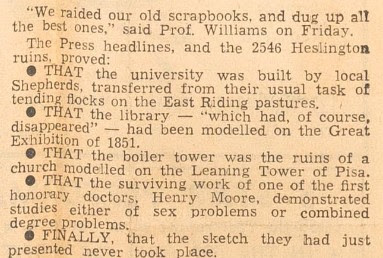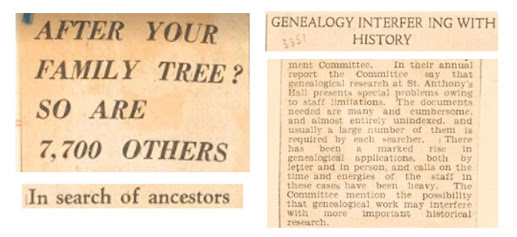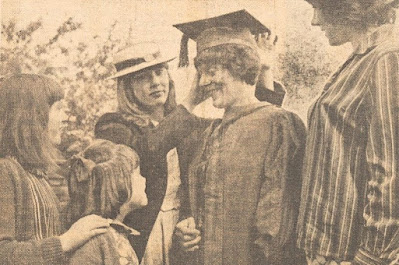By Sally-Anne Shearn
In June 1845, The
Morning Post reported that the residents of Loughborough had been witness
to an ‘imposing spectacle’ of a funeral, ‘amid
rites and observances of a nature so unusual as to well merit the fullest notice’.
The deceased was Lady Mary Anne Arundell, the widow of James, 10th Baron
Arundell of Wardour Castle, and the observances were Roman Catholic, presided
over by the Italian Father Pagani, Superior of nearby Ratcliffe
College.
The
funeral, and the rather saintly qualities of Lady Arundell, was reported on in
great detail in The Tablet, a Catholic paper, as well as The Morning
Post, but another source of information about the life and death of Lady
Arundell, and her contributions to Loughborough, exists at the Borthwick
Institute for Archives, thanks to the survival of the letters of her ‘most
attached’ friend Henrietta Crewe. Henrietta’s letters to her sister and
confidante Annabel Crewe, later Annabel Milnes, wife of Richard Monckton
Milnes, 1st Baron Houghton, provide a window into the life and personality of
Lady Arundell, her decision to move to Loughborough, and the events that
followed when she set out to bring an Italian convent and school to a small
Leicestershire town.
Lady
Mary Anne Nugent-Temple-Grenville was born in 1787, the only daughter of the
1st Marquess of Buckingham and a granddaughter of George Grenville, Prime
Minister between 1763 and 1765. Although her father, the Marquess, was a
Protestant, an 1886 Life of Antonio Rosmini Serbati, Catholic priest,
theologian, and founder of the Institute of Charity, claims that her mother,
Mary Nugent, the daughter of the Irish Viscount Clare, was Catholic and that it
was by her example that the young Lady Mary was first introduced to the faith.
 |
Lady Mary Anne Nugent-Temple-Grenville by John Hoppner (19th
century) Wikimedia Commons |
She
converted formally to Roman Catholicism in 1810 and in 1811 she married the
Catholic James Arundell, then heir to the 9th Baron of Wardour. He
succeeded as the 10th Baron in 1817. Lady Arundell and her husband travelled
widely on the continent, and it was in Italy in the early 1830s that they made
the acquaintance of Rosmini himself and were first introduced to his Institute
of Charity. The institute was then still in its infancy, having been
founded in 1828. It was dedicated to charitable work in all its forms but
focused particularly on pastoral and spiritual care, education, and care for
the sick, poor, and marginalised, work that greatly appealed to Lady
Arundell. The Institute was approved formally as a religious congregation
by Pope Gregory XVI in 1838.
Rosmini
wrote to Lady Arundell personally in 1834 when Lord Arundell died unexpectedly
at Rome, leaving her a widow at the age of only 47. She returned to
England alone, and at some point in the next few years moved to Bath to take up
residence at Prior Park, the Roman Catholic college established by Bishop Peter
Augustine Baines in 1828. There too, she found the influence of Rosmini,
who had sent members of his Institute to teach at the college at Baines’ request.
The first was Father Luigi Gentili, followed later by Dr Pagani. A novice
from Ampleforth Abbey who studied at Prior Park, Moses Furlong, would also
later join the Institute and become spiritual advisor to Lady Arundell.
 |
| Francesco Hayez, Ritratto di Antonio Rosmini (1853) Wikimedia Commons |
It
seems to have been at Prior Park that Lady Arundell met and became friends with
Henrietta Crewe. Despite their differences in age (Henrietta was 21 years
her junior), the two women had much in common. Like Lady Arundell,
Henrietta was born to a wealthy and well-connected Protestant family, she was
the granddaughter of the 1st Baron Crewe and his wife Frances Anne Greville,
and she was also a convert to the Catholic faith. Between 1829 and 1836
she had lived at Liège in Belgium with her estranged
father, the 2nd Baron Crewe, and it was here that her interest in the Catholic
faith led her not only to convert but also to make plans to join a convent - an
ambition which was ultimately forbidden by her family.
Henrietta
had already made several visits to Prior Park in the early 1830s during her
regular trips back to England, but in 1836, following the death of her father,
she returned to England for good and took up residence at The Priory, a house
in the grounds. In these decades Prior Park would seem to have been
something of a haven for a small circle of well-bred Catholic ladies who were
regular visitors, staying either in Bath or at the college itself, and deeply
devoted to the colourful and charismatic Bishop Baines. Some, like
Henrietta, even invested money in the enterprise, although few saw a return on
their investments. It is not clear from Henrietta’s letters when she and
Lady Arundell first met. In a letter of 1841 Henrietta mentions Lady
Arundell’s visit of two years previously ‘before she had been quite able to settle
about returning.’
Evidently, she had
made up her mind by May 1840 when Henrietta writes of her familiarly as a
fellow resident and close friend. The accounts of Lady Arundell’s funeral
describe her as a ‘rigid Catholic’, living a life of ‘extraordinary self-denial
and charity’, but it is clear from Henrietta’s letters to her sister that she
was far more than this rather pious epithet suggests. Attempting to sum
up her ‘darling friend’ in 1843, Henrietta writes of the ‘freshness, & originality,
& fun, & supremely delightful nonsense of her’, recalling ‘happy Monday
evenings’ spent together reading aloud from the latest serialised novel by
Charles Dickens, long conversations that ‘she always contrived to render
merry’, and regular lively visits from her younger brother Lord Nugent and his
family to whom Lady Arundell was very close. ‘There never was such
an attachment,’ Henrietta had written in an earlier letter, ‘as between that
brother & sister’.
But Lady Arundell
could not be fully content with her life at Bath, busy and enjoyable as it
was. As she revealed to Henrietta, she had long cherished hopes of
founding a convent in England and perhaps even joining it herself. She had
talked of it with her husband during their marriage and they had both agreed
that whoever should survive the other would embrace a religious life, she as a
nun of some sort and he as a Jesuit. Her plan was initially to establish
a convent near Bath, where the sisters could run a school for the poor, but finding
an affordable house proved difficult and her choice of religious order
unexpectedly contentious. Bishop Baines, according to Henrietta, favoured
the Sisters of Charity or Sisters of Mercy, but Lady Arundell had her heart set
upon the Italian ‘Suore della Providenza’ or Sisters of Providence of Rosmini’s
own Institute of Charity, commonly known as the Rosminian Sisters of
Providence.
It is likely there
was more to Baines’ opposition than Henrietta knew or wished to reveal to Annabel,
who had a persistent suspicion of all things Catholic. By 1840 the
relationship between Baines and Rosmini was strained. Baines’ biographer
Pamela J. Gilbert characterises Baines as something of a flawed genius, a
brilliant educationalist but obstinate, antagonistic, and as likely to create
enemies as loyal followers like Henrietta. It was certainly so with
Rosmini and his followers at Prior Park. When admission numbers began to
fall in the 1830s Baines blamed the strict regime introduced by Father Gentili
and set about limiting his authority and finally removing him from the college
altogether. In 1838 he sent him to a convent at Stapehill and then to
another at Spettisbury near Blandford. Rosmini
was forced to appoint the relative newcomer, Dr Pagani, as Superior of the
Institute at Prior Park in his place and withdraw Gentili back to Italy.
After a brief period there however, Rosmini sent Gentili to England to take up
residence as chaplain to Ambrose Lisle March Phillipps, a Roman Catholic convert,
disliked by Baines, who was active in the Catholic revival movement in
England. From Phillipps’ home at Grace Dieu manor, near Loughborough,
Gentili ran a hugely successful Catholic mission and was credited with
converting several hundred people to the faith. In August 1842 Rosmini
took the decision to withdraw all remaining Rosminian brethren from Prior Park
and to establish a new foundation in Leicestershire in the Midland
District. Fathers Pagani and Furlong left Prior Park later that month and
joined Father Gentili in Loughborough at the first house of the Institute of
Charity in England.
 |
| Letter 243 from Henrietta Crewe to Annabel Crewe, Milnes Coates Archive |
It is perhaps
unsurprising then that when Lady Arundell’s plans for a Bath foundation were
abandoned she would turn her attention instead to Loughborough, now the centre
of Rosminian work in England. In March 1843 Henrietta was finally able to
write to her sister to reveal all, for ‘the embargo has been taken off and my
lips unsealed - Before...I was under both orders and a promise not to mention
it to any one.’ Lady Arundell had indeed settled upon ‘the little
stocking-weaving Town’ of Loughborough for her convent. The presiding
Bishop, Bishop Walsh, had no objection to Lady Arundell’s choice of religious
sisters, Rosmini himself approved, and a house was found ‘in every respect
adapted to the purpose’ and evidently cheaper, ‘financial difficulties’ being
‘not so great in that neighbourhood’.
Lady Arundell left
Bath on the 22nd of February and Gilbert writes that Baines felt Lady
Arundell’s defection from the college sorely, although Henrietta describes how
the Bishop appeared at the door of Prior Park at the last moment to give her
his blessing. Her leaving was evidently a painful subject for Henrietta,
and for Lady Arundell too who wrote that no words could express what she felt
and always should feel on the matter. ‘I, who have so few friends! at
leaving one who I feel is one of the best!’
After a stay of
several weeks with the Phillipps’ family at Grace Dieu, Lady Arundell finally
took possession of her new home in Loughborough. She wrote to Henrietta
soon after her arrival and regularly thereafter. Her first weeks were
spent ‘shopping- furniture-buying, & arranging’ the house, in what she
unfortunately calls the ‘worst & roughest paved town in England’. She
was accompanied there by her butler and cook, a Mr and Mrs Doughty who had been
in her service for more than thirty years. The house was called Paget’s
House and was situated on Woodgate. After
her first visit later in 1843 Henrietta described it to Annabel. It was a
half modern, half Elizabethan house with ample accommodation for a community of
six or eight Sisters of Charity, besides Lady Arundell’s own apartment, and a
room which had been converted into a chapel for daily mass. Lady
Arundell’s drawing room and bedroom looked out over the ‘quiet shady garden’ at
the rear of the house ‘where the Sisters will be able to breathe a little fresh
air and recreate from their labours being unlooked’. At present the
garden was only a lawn but Lady Arundell had plans to plant some flower beds in
the autumn. The garden door opened on to a road leading into the country
and the country thereabouts was, to Henrietta’s unflattering surprise,
‘extremely pretty - the whole district of Charnwood Forest forming a sort of
oasis in the otherwise ugly county of Leicestershire’.
By Henrietta’s second
visit Lady Arundell had made a few additional alterations, particularly to her
drawing room where she had created a little greenhouse ‘full of flowers and birds’
with the ‘prettiest effect imaginable’ by adding a second sheet of glass in
front of the lower half of the large window. The addition was practical
as well as pretty for Henrietta reports that the rest of the house was
noticeably cold, with no carpets due to ‘Conventual simplicity’.
Henrietta greatly
enjoyed her first visit to Loughborough in September 1843. As well as seeing the new house, she visited
Grace Dieu and met the ‘cheerful’ and welcoming Phillipps family, dined with
Lady Arundell and Father Gentili (‘a very superior person’ as she wrote to Annabel)
and saw the new Catholic church at Shepshed, designed by Augustus Pugin. She also drove out to the recently founded Cistercian
monastery at Mount St Bernard, whose permanent buildings were also designed by
Pugin. It was a place she had long
wished to see, and she professed herself even more gratified than she had
expected at the sight of the flourishing farm amidst the ‘smiling landscape’
and the charitable works of the brothers, a much needed alternative, in her
eyes, to the grudging aid offered by the union workhouses.
 |
| The Milnes Coates Crewe correspondence |
She was disappointed
however, on this occasion, not to meet any of the Sisters of Providence who
were to labour alongside Lady Arundell. The
two ‘ladies from Milan’ chosen by Rosmini to begin the convent and run the
school, Sister Maria Francesca Parea and Sister Maria Anastasia Samonini, were
still ‘waiting for a boat’ and would reach Loughborough the following month
after a journey of twelve days. It was in mid-October then that two Roman
Catholic nuns appeared on the streets of Loughborough for the first time in
their black habits and stiff white veils, to the outrage of many of the town’s
Protestant residents. ‘Already they have been obliged to have black poke
bonnets and veils concocted for going out of doors’, Henrietta wrote just a few
months later, ‘as the three times that they ventured forth in their white head
gear, they were regularly mobbed.’ The last time was ‘the worst of all,
and the poor little things were a little frightened as well as incommoded by
the crowd’ that the change of clothing was deemed a necessity.
By the time Henrietta
met the nuns in person in early 1844, they were settling into their new
life. Henrietta reports that the elder of the two, Superiora, was still
struggling with the language, but the younger, Suor Anastasia, was making better
progress. They already had two English postulants, a widow and a young
girl, who would soon commence their novitiate. The first postulant took
the habit on the Feast of the Annunciation in 1844 and the small community began
its life with Suor Maria Francesca as Superior and Suor Anastasia as Mistress
of Novices.
The nuns formally
took charge of the school in March 1844, becoming the first religious sisters
to run a Catholic day school in England in the nineteenth century. An
article in the Catholic Herald in 1985 provides some details as to the
layout of the school. Lady Arundell had adapted the stables of the house
for an infants’ school and made the loft above the coach house into a classroom
for the older girls. Before the nuns took charge, lessons were being
given by a Mrs Moon, a ‘kind mistress’ who Henrietta notes had ‘the best that
Loughbro’ could supply, but very far from what is requisite’, and Lady Arundell
herself who devoted an hour or two each day to it. Now the nuns would
begin to teach the school ‘according to their own method’, although given the
language barriers Henrietta writes that they accepted there might be a few
‘spropositi’ (an Italian word for blunders) along the way.
Whatever spropositi
there might have been, the school and convent continued to grow and to thrive,
particularly after the arrival of Mary Barbara Amherst as a postulant in
1845. The sister of the Bishop of Northampton, as Mary Agnes Amherst she
would become the first English Superior of the Sisters of Providence and a
central figure in the growth of the order’s work in England.
Sadly, Lady Arundell
would not live long enough to see these developments. She died in June
1845, only two years after her arrival in the town and before she had seen her
dream of erecting a proper convent building realised. On hearing of her
friend being suddenly taken ill, Henrietta immediately set out for Loughborough
but arrived too late. ‘You did not, could not know how very dearly I
loved her’ she wrote to Annabel that night, from her room at the convent, ‘or
how immense a loss it is to me’. She describes the arrival of Lord
Nugent, whose ‘voice and manner’ she would never forget, and the long and
arduous day of her funeral when she resolved to follow her ‘darling Mimi’ with
her prayers to her last resting place. She couldn’t help but note that the
route along the streets to the little Catholic chapel was the same one they had
so often trodden together to attend prayers. Lady Arundell left money
to continue her work in Loughborough and instructions to be buried at the
nearby Ratcliffe College, recently established by Rosmini and Father Gentili.
After Lady Arundell’s
death Henrietta mentions Loughborough only rarely, but it is clear she kept up
with the progress of her friend’s work there and in 1848 she made another
visit. Writing afterwards from her brother’s grand home at Crewe Hall in
Cheshire she calls the busy house party there her ‘little penance after the delights
of dear Loughboro’. In answer to Annabel’s concern, she assures her that
‘it is scarcely sad to go there, my dearest, I cannot explain to you what it is
- I only know that it is luxury. I feel as if I had her still when I am in
those darling scenes where we have so often prayed together - where we last
parted - where she still lives in all these good works which it has pleased God
to bless in so very wonderful a manner’. To Henrietta’s delight ‘her
Nuns’ had increased in number from 3 to 17 and a ‘charming convent building’ was
being built just out of the town, on the Park Road.
Our Lady’s Convent
School would open in 1850 and today, more than 170 years on, the work begun by
Lady Arundell and the Italian sisters lives on as Loughborough Amherst School.
Bibliography
Milnes Coates Archive, Borthwick Institute for Archives
‘Importing the Rosminians’, in The Catholic Herald, 25 October 1985
Sister Maria Bruna Ferretti, The Rosminian Sisters of Providence, ed. J. Anthony Dewhirst (2000)
Pamela J. Gilbert, This Restless Prelate: Bishop Peter Baines 1786-1843 (2006)
William Lockhart, Life
of Antonio Rosmini Serbati, Founder of the Institute of Charity, Volume II
(1886)
John Morris, A
Selection from the Ascetical Letters of Antonio Rosmini, Volume II 1832-1836
(1995)





















